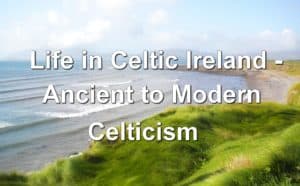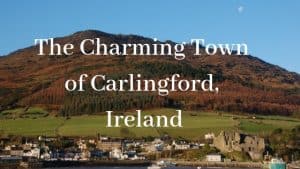Celtic Music: The Celtic Influence on Modern Music Genres

Updated On: April 15, 2024 by Maha Yassin
Celtic music has played an influential role in shaping various modern music genres. Tracing its origins back to the cultural practices of the Celts, it embodies a rich mix of history, tradition, and musical ingenuity. Through the migration of populations and the inevitable cross-cultural exchanges, Celtic music has not only survived into the modern era but has also contributed to the development of distinctive music styles worldwide. Its characteristics are notably present in genres such as country music in the Americas, where it merged with other cultural music traditions.
Celtic music’s influence extends beyond its geographical origins in our culturally interconnected world. Traditional Celtic instruments, such as the fiddle, tin whistle, and uilleann pipes, have been integrated into contemporary music, creating unique hybrid genres. This amalgamation of traditional Celtic sounds with new musical styles underscores the genre’s versatility and enduring appeal. Moreover, the thematic elements of Celtic music, often tied to identity and politics, continue to resonate with audiences, maintaining its relevance and effect on music across the globe.
Historical Roots of Celtic Music

Tracing the origins of Celtic music reveals a tapestry of cultural interplay and enduring traditions. We’ll explore the ancient influences and paramount components that have shaped the music of the Celtic nations.
Celtic Nations and Traditional Influence
The Celtic nations, including Ireland, Scotland, Wales, Brittany, Cornwall, and the Isle of Man, share a deep-seated heritage of traditional music. Each region has fostered its distinct variations. For instance, Irish traditional music is characterised by lively jigs and reels, while the haunting melodies of Scottish folk often incorporate the pentatonic scale. Welsh music is noted for its melodic harp arrangements, and the influence of Breton elements is pronounced in Brittany.
Instruments and Musical Forms
The instruments that are key to the unique sound of Celtic music are the fiddle, tin whistle, uilleann pipes, and the Celtic harp. String instruments like the bouzouki and the bodhrán, a type of drum, also play vital roles. Celtic music encompasses various musical forms – from lively dance tunes like jigs, reels, and hornpipes to more lyrical airs and ballads, each telling a story or expressing an emotion intrinsic to the Celtic experience.
Language and Cultural Identity
The Celtic nations’ languages have significantly influenced their music’s lyrical content. Gaelic, in Ireland and Scotland, along with Welsh in Wales and Breton in Brittany, contribute to the distinctive identity of their respective musical traditions. Songs in these languages carry the history and stories of their people, keeping the cultural identity alive. Musicians often pass down songs orally, a testament to the long-standing tradition of preserving language through music.
Evolution of Celtic Music in the 20th Century

The 20th century witnessed a profound evolution in Celtic music, shaped by revivals and global conflicts, which saw it influencing and blending with other genres.
Irish and Scottish Music Revival
In the earlier part of the century, interest in Irish and Scottish music was markedly revived. This period was characterised by collections and recordings of traditional tunes and the reappraisal of native music often marginalised by mainstream audiences. Pioneers like the Irish band Clannad brought a new age of appreciation for Celtic tunes by blending them with other music styles, creating what would become known as Celtic fusion music.
Celtic Music in the World Wars
During both World Wars, Celtic music served as a poignant reminder of home for soldiers abroad and sustained morale on the home front. In conflict and loss, traditional and new tunes emerged that reflected the experiences and sentiments of those affected by the wars, adding a rich emotional layer to the music’s evolving narrative.
The Folk Movement and Beyond
The mid-20th century folk movement saw American folk music intertwine with Celtic roots music, creating hybrid genres and reinforcing the presence of Celtic influence. Artists like Alan Stivell were instrumental in further popularising Celtic music across the globe. By the century’s end, Celtic melodies had proven their enduring appeal and versatility in the modern music scene.
As we look back at the evolution of Celtic music in the 20th century, it’s evident that the genre has not only preserved its heritage but has also willingly embraced new influences, extending its reach and resonance within the wider tapestry of world music.
Celtic Instruments

In this section, we explore the traditional instruments that have shaped the distinctive sound of Celtic music.
String Instruments
Celtic Harp: A symbol of Ireland often seen on Guinness bottles, the Celtic harp is a pivotal instrument in the tradition of Celtic music. Towering around four feet with 34 strings, it provides a range of melodies and accompaniments to storytelling, anchoring the ethereal sound often associated with Celtic tunes.
Fiddle: Fiddle is a staple in Celtic music, shared much with the classical violin. Distinct in its playing style, it contributes both melodic lead and rhythmic backing to Celtic ensembles.
Wind Instruments
Tin Whistle: Simple yet expressive, the tin whistle (or penny whistle) is recognised for its high-pitched, piercing melodies that can cut through the densest musical arrangements.
Uilleann Pipes: Known for their less abrasive sound than Scottish bagpipes, the uilleann pipes are a complex bellows-blown bagpipe with a haunting and distinctively Irish sound.
Flute: The wooden flute is traditionally used in Celtic music, offering a warm and resonant tone capable of both rapid, upbeat tunes and slower, more melancholy airs.
Percussion and Other Instruments
Bodhrán: This shallow, hand-held drum is played with a beater, adding a percussive heartbeat to music sessions and Celtic rhythms.
Accordion and Concertina: Both the piano accordion and the concertina inject a lively, reedy timbre to the ensemble with the ability to cover both melody and accompaniment roles, which can be heard across many Celtic genres.
Genres and Fusion

In exploring the Celtic influence on modern music genres, we discover a rich tapestry where traditional melodies blend with contemporary sounds, creating fusion genres that resonate with audiences worldwide.
Celtic Rock and Punk
Celtic rock pioneers like Horslips laid the groundwork for blending folk tunes with rock elements. This genre’s energetic fusion is exemplified by bands like The Pogues and Flogging Molly, who inject punk vigour into Celtic music traditions. Mixing electric guitars with traditional instruments like the tin whistle and fiddle, these groups embody the spirit of Celtic rock and punk, producing nostalgic and rebellious sounds.
- Key Characteristics:
- Distorted electric guitars
- Traditional Celtic instruments
- Vigorous, up-tempo rhythms
Celtic and American Music Influences
Celtic music has deeply influenced American genres, most notably country music. The traditional sounds carried by immigrants found new life in the Appalachian and Blue Ridge Mountains, merging with other cultural influences to form the roots of American music. The Corrs‘ pop and folk blend beautifully illustrates Celtic fusion, weaving together American and Celtic soundscapes.
- Influential Bands/Artists:
- The Corrs
- Black 47
Celtic Metal and Other Hybrids
Beyond rock and country, Celtic music has made a remarkable impact on metal, creating the niche Celtic metal genre. This fusion delivers a powerful blend of mythology-themed lyrics and the grandeur of metal with Celtic melodies and rhythms. Bands like Dropkick Murphys often incorporate cultural identity and heritage themes, while the instrumentation ranges from typical metal setups to bagpipes and harps.
- Typical Elements:
- Heavy guitar riffs
- Folk-driven lyrical themes
- Dynamic use of traditional instruments
Celtic Music in the Americas
Celtic music has significantly impacted the musical tapestry of the Americas, especially through the contributions of Irish and Scottish immigrants and their descendants.
Irish and Scottish Diaspora
Irish and Scottish music has been an integral part of the American cultural heritage for centuries, especially in the United States and Canada. The Irish-American community has been vital in preserving and evolving these traditions. New York has long been a hub for Irish American music, with countless performances and cultural gatherings. Similarly, Scots-Irish communities have been influential, especially in Appalachian regions, where their music blended with sounds from African American communities and others to contribute to creating distinctive American music genres.
In Canada, particularly in Atlantic Canada, Newfoundland, and Cape Breton, Celtic music has experienced a revival and maintains a significant presence. Here, the music has preserved its original spirit and integrated regional characteristics that distinguish it from its origin.
Development of Regional Styles
Our analysis reveals how these transplanted Celtic sounds evolved into regional styles unique to North America. In areas like Atlantic Canada and Newfoundland, Celtic music often preserves a style reminiscent of its roots yet has a distinctive Canadian flavour. Meanwhile, Celtic music has intermingled with other genres in the United States, giving rise to new forms such as country music.
In our journey through the musical landscape, we’ve seen regional adaptations where the core elements of Celtic music – its melodies and rhythms – have woven seamlessly into the fabric of various American music streams. For instance, country music, which is often associated with the heart of America, has clear Celtic resonances, especially visible in the tunes and instruments employed.
Through our exploration, we feel a deep connection to these musical traditions as they are a testament to the cultural exchange that defines the musical heritage of the Americas.
Celtic Music and Dance
In exploring the rich tapestry of Celtic music and dance, we discover a tradition deeply intertwined with history and community. It’s a realm marked by the lively rhythms of reels and jigs, the subtlety of sean-nós, and the celebration inherent in Celtic festivals.
Traditional Forms of Dance
Within the traditional forms of Celtic dance, we find a vibrant mix of fast-paced jigs and the flowing motions of reels. Jigs, typically danced in 6/8 time, feature a rapid succession of steps and hops, demanding agility and stamina from dancers. On the other hand, the reel flows in a smooth 4/4 time, with dancers weaving around each other in patterns that mirror the music’s intricate melodies. At festivals, these traditional dances foster a sense of unity and joy as young and old attendees participate in these communal expressions of culture.
Evolution and Modern Interpretations
As time has passed, Celtic music and dance have embraced evolution, giving rise to modern interpretations that blend old forms with new influences. The quickstep and the foxtrot, although not traditional to Celtic heritage, have been incorporated within the repertoire of Celtic dancers, showcasing a versatility that spans beyond customary boundaries. Sean-nós, a more freeform and expressive style of traditional Irish dance, has also seen a resurgence, indicating a reverence for the old even within modern contexts. These evolutionary forms underscore the dynamic nature of Celtic art, proving it to be adaptable and influential as it permeates various aspects of contemporary music and dance.
Celtic Music, Identity, and Politics

In exploring the intricate weave of Celtic music, we must acknowledge its profound connection with identity and politics, particularly through elements of nationalism and expressions of resistance.
Nationalism and Celtic Identity
Celtic music has long been a cornerstone for national identity in Ireland and Scotland. Traditional Irish music, with its rich repertoire of jigs, reels and emigrant ballads, encapsulates the spirit of Irish nationalism. It has been instrumental in maintaining a distinct Irish cultural identity, especially in the face of historical challenges and British influence.
Similarly, Scottish music underscores Scotland’s unique heritage. The sounds of bagpipes and the stories told through Scottish verse and song have been vital in asserting a Celtic identity separate from English and other regional identities within the UK. These expressions of cultural nationalism are not merely about preservation but a celebration of a collective past and present.
Music as a Form of Expression and Resistance
Historically, Celtic music has also acted as a dynamic tool for political expression and resistance. Emigrant ballads, for example, conveyed the Irish diaspora’s raw emotions and political views. They often reflected sentiments of displacement, serving as a form of solace and a subtle method of political commentary.
These ballads and other forms of Celtic music carry the weight of history, wherein songs were created and sung as acts of defiance against colonial oppression or as rallying cries for political movements. By weaving political messages with melody, Celtic music provides a powerful narrative that aligns closely with political autonomy and self-determination struggles.
Throughout our cultural journeys, we musically encapsulate the essence of who we are – reflecting the politics of our history, the strife for our freedom, and the pride in our Celtic roots.
Influential Musicians and Bands

In reflecting on the impactful figures in modern music genres, we recognise several key musicians and bands whose work has been foundational. Their contributions have notably shaped the landscape of Celtic and global music scenes.
Pioneers of Modern Celtic Music
- Alan Stivell: Heralded as a spearhead for the renaissance of Celtic music, Alan Stivell brought the Celtic harp and traditional melodies to a broader audience, fusing elements with modern sounds and recording techniques.
- Clannad: This family band from County Donegal has been crucial in bringing Irish language songs and themes into the contemporary era. Their ethereal blend of traditional Irish music with pop and new-age influences has won them international acclaim.
- The Pogues: Known for their raw and energetic style, They injected punk vitality into Irish folk music, becoming genre icons and influencing countless artists.
Contemporary Celtic Music Artists
- The Corrs: This sibling group from Dundalk has skillfully blended pop with traditional Celtic music, creating a sound that resonates globally and brings further attention to Irish musical traditions.
- Loreena McKennitt: Her music, rich with Celtic and Middle Eastern motifs, has enchanted audiences worldwide. Loreena McKennitt skilfully intertwines storytelling with melody to keep the essence of Celtic music alive.
- Michael Coleman: Though his era predates what we consider ‘modern’, Coleman’s influence reverberates. His 1920s Sligo-style fiddle recordings continue to inspire traditional Irish musicians today.
Preservation and Education

We witness the vitality of Celtic music’s tradition through its dynamic preservation and education efforts. These initiatives ensure that the rich cultural heritage of the Celtic peoples continues to inspire and resonate within modern music genres.
Role of Festivals and Schools
Festivals serve as key platforms for celebrating and perpetuating Celtic music. Through events such as folk music festivals and bardic gatherings, attendees experience live performances that showcase traditional melodies and contemporary adaptations. Moreover, schools dedicated to Celtic music provide structured learning, where students immerse themselves in the artistry of Celtic instruments and the history behind the tunes. This hands-on approach to music education helps to foster a new generation of musicians well-versed in both the technical skills and the cultural significance of Celtic music.
Documentation and Archiving
Documentation and archiving are crucial for the longevity of any musical tradition. Efforts to preserve Celtic music include a systematic collection undertaken in the late 18th century and modern digital archiving. Historical scores, recordings, and oral histories are meticulously documented to ensure that the music and its narratives are not lost to time. Organisations and scholars meticulously compile these resources, contributing to an ever-growing archive accessible to enthusiasts and academics, promoting continuous learning and appreciation for Celtic music’s evolving identity.
Modern-Day Legacy and Commercialisation

Celtic music continues to thrive and adapt in the contemporary music scene. We see a significant commercialisation of this genre, especially in its fusion with other styles. Incorporating traditional instruments like the fiddle, bodhrán, and tin whistle into modern compositions has broadened the appeal of Celtic sounds. This transformation bridges the gap between old and new, creating what many recognise as ‘Celtic Fusion.’
In urban hubs such as New York City, Celtic music resonates within the City Center Ballroom, drawing crowds enchanted by melodic narratives and rhythmic dances. With these venues, Celtic music becomes a commercial powerhouse beyond its regional origins, introducing worldwide audiences to its rich heritage.
Festivals have become crucial in celebrating and commercialising Celtic tradition. Events like the Celtic Colours International Festival gather musicians from around the world to Nova Scotia, turning tradition into a spectacle enjoyed by global audiences and creating a lucrative market centred around Celtic culture.
Modern Celtic Influences Examples Instruments Fiddle, Tin Whistle Fusion Incorporating rock, jazz, or pop Venues New York City Center Ballroom Festivals Celtic Colours International Festival
These elements forge a new path for the enduring spirit of Celtic music while ensuring its sustainability through commercial means. Our musicians and tradition-bearers continue to embellish and expand the genre, ensuring that Celtic music is significant in the world’s cultural tapestry.
Celtic Music’s Influence on Modern Music Genres
Celtic music has significantly impacted various modern music genres with its distinctive melodies and rhythmic patterns. The genre originated from the folk musical traditions of the Celtic people in Western Europe and has since permeated a diverse range of musical styles.
Rock and Roll: Celtic music’s fusion into rock and roll is evident, with bands like The Pogues and The Saw Doctors blending traditional Celtic instruments and rhythms into their works, creating Celtic rock hybrids. This cross-pollination has added a unique twist to the rock genre.
Punk Music: Likewise, the punk scene has witnessed the incorporation of Celtic elements, adding a raw, energetic edge to punk music and giving rise to a whole sub-genre often referred to as Celtic punk.
Folk Music: Within folk music, Celtic influence remains deeply rooted. The genre has borrowed heavily from the rich tapestry of Celtic melodies, integrating them into traditional and contemporary folk music.
- Influence on Other Folk Traditions: It doesn’t end with rock variants; other folk-inspired genres worldwide have also seen Celtic music’s influence, including Angelo-Celtic traditions, which integrate aspects of Celtic and English folk music.
Contemporary Hybrids: Modern artists often experiment by creating hybrids, fusing Celtic motifs with various music genres, from pop to sacred hymns and even influences from African American spirituals.
We observe mutual influences, where not only does Celtic music provide a creative fountain for other genres but also evolves by drawing elements from those same genres it inspires. This ongoing cultural exchange has enriched the global music landscape, ensuring that the essence of Celtic music continues to thrive and adapt in today’s diverse musical world.
FAQs
In this section, we explore the enduring impact of Celtic music on modern genres, tracing the threads from ancient traditions to contemporary sounds.
How have Celtic traditions shaped the styles of contemporary genres?
Celtic traditions have infused contemporary music with distinctive instruments like the bodhrán and tin whistle, contributing to the textural richness found in many modern genres. The emergence of new musical styles is a testament to the adaptability and influence of these ancient sounds.
How has Celtic music influenced the development of folk and rock music?
Celtic music has significantly influenced folk music by sharing its narrative style and communal spirit. In contrast, rock music has borrowed its energetic rhythms and use of specific instruments like the fiddle. Bands often incorporate these elements to create a unique sound that resonates with a wider audience, evidencing the two-way street between Celtic and rock music.
What are the defining characteristics of Celtic music that have permeated popular music?
The defining characteristics of Celtic music, such as repetitive melodies, ornamentation, and a storytelling lyrical approach, have found their way into popular music, adding layers of emotional and musical depth.
Which modern bands or artists show a clear inspiration from Celtic music?
Modern bands that showcase a clear inspiration from Celtic music include the Dropkick Murphys and Flogging Molly. Their use of traditional instruments and incorporating Irish themes continue to attract global audiences, reflecting the genre’s widespread appeal.
Can the impact of Celtic music on jazz and fusion genres be identified?
The impact of Celtic music on jazz and fusion genres can be identified, especially in the way melodies and improvisational styles have interwoven, creating a harmony that enriches both traditions.
What is the significance of Irish musical elements in today’s global music scene?
Irish musical elements have become a significant part of today’s global music scene by contributing to its diversity and showcasing the cultural heritage of Ireland. They remind us that music is a universal language that can convey the spirit of a nation beyond its borders.






